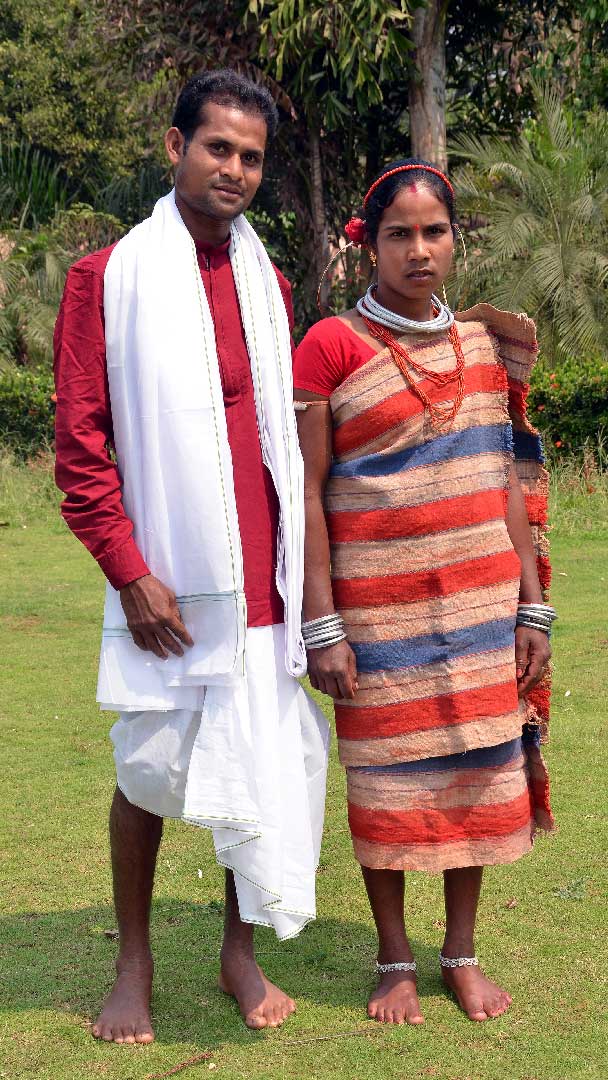TRIBES OF ODISHA
TRIBES OF ODISHA
Gadaba
Bodo Gadaba, Gutob Gadaba, Kapu Gadaba, Ollara Gadaba, Parenga Gadaba, Sano Gadaba
Region: Koraput and Malkangiri
Population*: 84,689
Language: Gutob and Ollari
Map: Click Here
Origin: The Gadaba are believed to have migrated out off their traditional home in the northern highlands of the Vindhya Mountains to settle in Odisha. The name Gadaba is derived from the word Gada which is the name of a stream in the Godavari valley.
Culture and Crafts: Dormitories are constructed for the unmarried boys and girls of the village. Fond of dance and music, the men play a variety of instruments like the tamudibaja, madal, tamak and mahuri. Songs are composed for specific occasions and festivities are accompanied by Dhemsa dance by the women of the community.
Occupation: Agriculture is supplemented with hunting, fishing and the collection of forest produce, with the hills surrounding the settlement used for shifting cultivation in the past. Cows and buffaloes are kept exclusively for ploughing the fields. Some of the Gadaba also engage in the making of brooms to be sold locally.
Video:
*Scheduled Tribes Population as per Census 2011 data. PVTGs Population as per Micro Project Survey Data, 2010
Gadaba
Bodo Gadaba, Gutob Gadaba, Kapu Gadaba, Ollara Gadaba, Parenga Gadaba, Sano Gadaba
Region: Koraput and Malkangiri
Population*: 84,689
Language: Gutob and Ollari
Map: Click Here
Origin: The Gadaba are believed to have migrated out off their traditional home in the northern highlands of the Vindhya Mountains to settle in Odisha. The name Gadaba is derived from the word Gada which is the name of a stream in the Godavari valley.
Culture and Crafts: Dormitories are constructed for the unmarried boys and girls of the village. Fond of dance and music, the men play a variety of instruments like the tamudibaja, madal, tamak and mahuri. Songs are composed for specific occasions and festivities are accompanied by Dhemsa dance by the women of the community.
Occupation: Agriculture is supplemented with hunting, fishing and the collection of forest produce, with the hills surrounding the settlement used for shifting cultivation in the past. Cows and buffaloes are kept exclusively for ploughing the fields. Some of the Gadaba also engage in the making of brooms to be sold locally.
Video:
*Scheduled Tribes Population as per Census 2011 data. PVTGs Population as per Micro Project Survey Data, 2010
Gadaba
Bodo Gadaba, Gutob Gadaba, Kapu Gadaba, Ollara Gadaba, Parenga Gadaba, Sano Gadaba
Region: Koraput and Malkangiri
Population*: 84,689
Language: Gutob and Ollari
Map: Click Here
Origin: The Gadaba are believed to have migrated out off their traditional home in the northern highlands of the Vindhya Mountains to settle in Odisha. The name Gadaba is derived from the word Gada which is the name of a stream in the Godavari valley.
Culture and Crafts: Dormitories are constructed for the unmarried boys and girls of the village. Fond of dance and music, the men play a variety of instruments like the tamudibaja, madal, tamak and mahuri. Songs are composed for specific occasions and festivities are accompanied by Dhemsa dance by the women of the community.
Occupation: Agriculture is supplemented with hunting, fishing and the collection of forest produce, with the hills surrounding the settlement used for shifting cultivation in the past. Cows and buffaloes are kept exclusively for ploughing the fields. Some of the Gadaba also engage in the making of brooms to be sold locally.
Video:
*Scheduled Tribes Population as per Census 2011 data. PVTGs Population as per Micro Project Survey Data, 2010
Gadaba
Bodo Gadaba, Gutob Gadaba, Kapu Gadaba, Ollara Gadaba, Parenga Gadaba, Sano Gadaba
Region: Koraput and Malkangiri
Population*: 84,689
Language: Gutob and Ollari
Map: Click Here
Origin: The Gadaba are believed to have migrated out off their traditional home in the northern highlands of the Vindhya Mountains to settle in Odisha. The name Gadaba is derived from the word Gada which is the name of a stream in the Godavari valley.
Culture and Crafts: Dormitories are constructed for the unmarried boys and girls of the village. Fond of dance and music, the men play a variety of instruments like the tamudibaja, madal, tamak and mahuri. Songs are composed for specific occasions and festivities are accompanied by Dhemsa dance by the women of the community.
Occupation: Agriculture is supplemented with hunting, fishing and the collection of forest produce, with the hills surrounding the settlement used for shifting cultivation in the past. Cows and buffaloes are kept exclusively for ploughing the fields. Some of the Gadaba also engage in the making of brooms to be sold locally.
Video:
*Scheduled Tribes Population as per Census 2011 data. PVTGs Population as per Micro Project Survey Data, 2010
PVTG Communities
62 Scheduled Tribes
PVTG Communities
62 Scheduled Tribes
PVTG Communities
62 Scheduled Tribes





